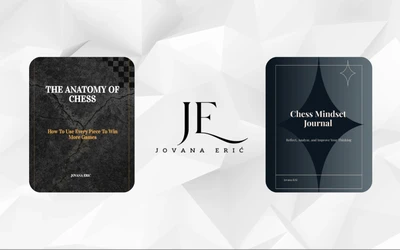
Jovana Erić
The Strengths of Each Chess Piece
The Pawn
Pawns may appear weak at first, but they play a huge role in the game. While often underestimated, they’re the foundation of any successful chess plan:
- Board Control: As the pawns move forward, they take control of key squares, making it harder for your opponent to maneuver.
- Promotion: If a pawn makes it all the way to the other side of the board it can transform into a more powerful piece, often a Queen.
- Pawn Structures: A solid pawn structure can control important squares, limit your opponent's options, and set the tempo of the game. Central pawns, when advanced, dominate important squares and provide space for other pieces to maneuver. On the flip side, weak pawns like isolated or doubled ones can become a real burden, giving your opponent easy targets.
- Sacrifice: Pawns are often sacrificed to gain positional or tactical advantages. Sacrificing a pawn, or going for a gambit, can open up the game, trick your opponent, or create weaknesses they can't easily fix.
- Pawns in the Endgame: With fewer pieces on the board, pawn structures become critical. Passed pawns are really powerful, often deciding the outcome of the game when there’s nothing stopping them.
Pawns are key at every stage of the game, helping you set up your plans and make your next move. Kind of like life, even the smallest actions can have a huge impact.
The Knight
The Knight’s unpredictable movement sets it apart from all other pieces. They don’t move in straight lines, and that makes them incredibly useful:
- L-Shaped Movement: The Knight’s ability to jump over pieces makes it highly effective in closed positions.
- Forking Ability: Knights excel at creating forks, threatening two or more pieces simultaneously.
- Central Power: A knight in the middle of the board can reach up to eight squares, making it super effective.
- Flexibility: Unlike Bishops, Knights don’t stick to one color of square, which gives them way more freedom to get where they’re needed.
Its tricky movement makes it hard for opponents to predict what’s coming next.
The Bishop
Bishops have long-range power, excelling in open positions:
- Diagonal Control: Bishops influence long diagonals, making them ideal for controlling distant squares.
- Speed and Range: Bishops can move across the board fast, making them great for both attacking and defending.
- Pair Synergy: Two Bishops complement each other, covering both light and dark squares for complete control.
- Pinning Ability: Bishops are excellent at pinning enemy pieces, creating tactical advantages.
Bishop’s strength grows as the board opens up, letting it cover more ground and make a bigger impact.

The Rook
The Rook is a strong piece, particularly in the endgame:
- Straight-Line Dominance: Rooks dominate in straight lines, controlling entire files and ranks, which means they can influence the board from a distance.
- Teamwork: When connected, Rooks become significantly stronger, taking control of the board and setting up strong attacks.
- King Safety: Rooks help with castling, ensuring the King’s safety and activating the Rook simultaneously.
- Endgame Strength: Rooks stand out in the endgame, defending your pawns while also cutting off your opponent’s king.
Rooks are at their strongest on open files and when coordinating effectively with other pieces.
The Queen
The Queen combines the abilities of several pieces, making it the most flexible and powerful piece on the board:
- All-Directional Movement: The Queen moves like both a Rook and Bishop, dominating files, ranks, and diagonals.
- Versatility: The Queen excels in attacking, pinning, and working with other pieces to deliver checkmate.
- Defense: The Queen is great at both attacking and defending, easily switching between the two, which makes it the most adaptable piece.
- Game-Changer: A well-placed queen can turn the game in your favor, especially during the middlegame or endgame.
The Queen can control large parts of the board, making it the most impactful and game-changing piece in chess.
The King
The king might be slow, but he’s the most important piece on the board. Everything revolves around keeping him safe:
- Game-Defining Role: If your king gets checkmated, the game’s over.
- Endgame Activity: Once the board clears up, the king becomes an active piece, helping pawns promote.
- Castling: The King enables a critical strategic move, castling, which secures safety while activating a Rook.
- Opposition: In the endgame, the King’s ability to control important squares and stop the opponent’s progress is crucial.
When the King is in the right spot, it goes from being a target to a powerful piece in the endgame.
All chess pieces make a unique contribution to the game, which is why there is power in diversity. Every piece has a specific movement and role that influences the game.
If you want to dive deeper into each piece's strengths, weaknesses, and strategies, check out my quick guide, The Anatomy of Chess: https://www.jovanaeric.com/product/the-anatomy-of-chess/
You may also like
 WGM jovanaeric
WGM jovanaericHow to Properly Analyze Your Games
Analyzing a chess game is a great way to improve your skills. Being more critical of your choices an… ebk1976
ebk1976Aging in Chess
The age too old for gold. CyberShredder
CyberShredderWorld Rapid and Blitz being absolute meme
Some news, memes, controversies WGM jovanaeric
WGM jovanaericMaster Piece Play & Chess Mindset
I’ve created digital resources to help players reflect and grow, including chess eBooks that break d… MEGALODON777hs
MEGALODON777hsWhen the Rat's Away, the Cats Will Play
My experiences at the 2024 Rapid World Championship WGM jovanaeric
WGM jovanaeric